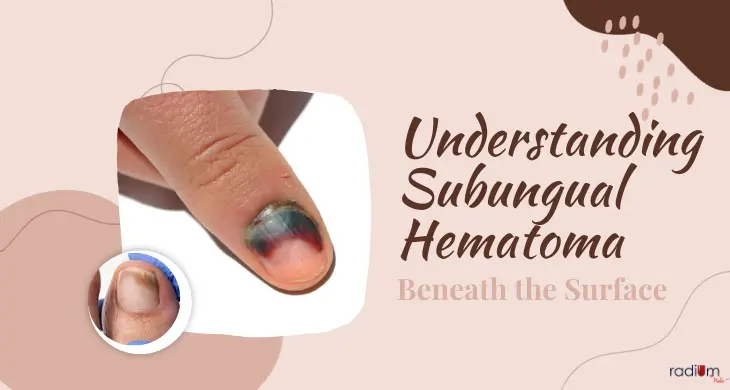Hidden beneath the surface of your nails lies a condition that, while often benign, can cause discomfort and concern. Subungual hematoma, a medical term that might sound intimidating, is actually a relatively common occurrence. In this comprehensive guide, we’ll delve into the world of subungual hematoma, peeling back the layers to reveal its causes, symptoms, and treatment options.
Whether you’ve recently experienced an injury or are simply curious about what lies beneath your nails, this exploration will provide you with the knowledge needed to understand, manage, and potentially prevent subungual hematoma. So, let’s embark on this journey of discovery to reveal the facts “beneath the surface.”
Unveiling Subungual Hematoma:
Subungual hematoma is a medical condition characterized by the accumulation of blood underneath the fingernail or toenail. It typically occurs as a result of direct trauma or injury to the nail, which can cause blood vessels beneath the nail to rupture and bleed. Subungual hematomas are often painful and are commonly referred to as “black nails” or “blood blisters” due to their appearance.
Key features of subungual hematomas include:
- Discoloration: The most noticeable sign is a dark discoloration of the affected nail, typically appearing as a deep red, purple, or black area. This discoloration is the trapped blood beneath the nail.
- Pain: Subungual hematomas can be painful, especially in the initial stages when blood accumulates under the nail and creates pressure. The pain may gradually subside as the blood clot stabilizes.
- Swelling: Swelling and throbbing around the affected area are common due to the pressure of the blood accumulating under the nail.
- Bruising: Surrounding skin may also exhibit bruising or discoloration due to the trauma.
Treatment for subungual hematoma primarily involves relieving pain and pressure. In some cases, healthcare providers may decide to drain the accumulated blood by creating a small hole in the nail. This procedure, known as trephination, can alleviate pain and promote healing. However, it is essential to seek medical advice and avoid attempting self-drainage, as it may lead to complications or infections.
Anatomy of Subungual Hematoma:
Beneath the Nail: Anatomy of Subungual Hematoma” explores the internal structure and dynamics of a subungual hematoma, a medical condition where blood accumulates beneath a fingernail or toenail. This condition often results from direct trauma or injury to the nail, leading to the rupture of blood vessels and bleeding beneath the nail. The article delves into the anatomy of the condition, explaining how blood pools under the nail, the associated symptoms, and potential treatment options.
Key points covered in this blog may include:
- The Nail Plate: An overview of the nail’s hard, protective outer layer, known as the nail plate. It serves as a barrier that traps blood beneath it during a subungual hematoma.
- Blood Accumulation: How and why blood accumulates beneath the nail due to trauma or injury. This includes the role of blood vessels in the nail bed and how they may rupture.
- Symptoms: Detailed descriptions of the typical symptoms of a subungual hematoma, such as discoloration, pain, swelling, and bruising. The article may explain why these symptoms occur.
- Pressure and Pain: An exploration of how the trapped blood creates pressure beneath the nail, leading to pain and discomfort for the affected individual.
- Drainage Procedures: Information on potential treatment options, including the drainage of blood to relieve pressure and pain. This may include trephination, a medical procedure to create a small hole in the nail for blood release.
The Impact of Trauma:
It delves into the profound and often enduring consequences of experiencing trauma, whether it be physical, emotional, or psychological. This article explores the wide-ranging effects that trauma can have on individuals, families, and communities. It also delves into the mechanisms through which trauma can leave a lasting impact.
Key points addressed in this blog might include:
- Types of Trauma: An overview of the various types of trauma, from physical injuries and accidents to emotional and psychological traumas resulting from experiences like abuse, violence, or natural disasters.
- Immediate Effects: A discussion of the immediate impact trauma can have on individuals, such as physical injuries, shock, and acute stress reactions.
- Long-Term Consequences: An exploration of the lasting effects of trauma, both on mental and physical health. This section may cover conditions like post-traumatic stress disorder (PTSD), anxiety, depression, chronic pain, and other health issues that can result from unresolved trauma.
- Impact on Relationships: A look at how trauma can affect personal relationships, including family dynamics, friendships, and romantic partnerships. It might discuss issues like trust, communication, and support.
- Community and Societal Impact: An examination of how trauma can extend beyond individual experiences to impact entire communities and societies. This can include discussions of collective trauma, such as the aftermath of wars or large-scale disasters.
- Resilience and Coping: The article may also touch on the potential for resilience and coping strategies to help individuals and communities recover from trauma and build a path towards healing.
It aims to provide insights into the far-reaching consequences of trauma and the importance of recognizing and addressing these effects. It may also offer guidance on seeking help and support for those who have experienced trauma.
When to Seek Medical Attention for Subungual Hematoma:
Subungual hematoma, the collection of blood underneath the nail, can result from various injuries or trauma to the fingers or toes. While many cases of subungual hematoma can be managed at home, there are certain situations where it’s crucial to seek immediate medical attention. This section provides guidelines on when it’s necessary to consult a healthcare professional for subungual hematoma.
1. Severe Pain and Discomfort:
- If the subungual hematoma causes severe pain that is difficult to manage with over-the-counter pain relievers, it’s advisable to seek medical attention. This may indicate a larger hematoma or associated complications.
2. Significant Bleeding:
- Excessive bleeding or profuse, uncontrolled bleeding should be a cause for concern. A healthcare provider can assess the extent of bleeding and provide appropriate treatment.
3. Signs of Infection:
- If the injured area shows signs of infection, such as redness, swelling, warmth, discharge, or increasing pain, medical attention is necessary. Infections can complicate the healing process and require antibiotics.
4. Change in Nail Color or Deformity:
- If the hematoma causes a visible change in the color or appearance of the nail, it may indicate damage to the nail bed or underlying structures. Consulting a medical professional can help assess the extent of the injury.
5. Numbness or Loss of Sensation:
- If the subungual hematoma results in numbness, loss of sensation, or compromised blood flow to the affected digit, immediate medical care is essential to prevent tissue damage.
6. Underlying Health Conditions:
- Individuals with underlying medical conditions that affect their blood clotting, such as hemophilia or certain medications, should consult a healthcare provider even for minor subungual hematomas.
Treatment and Management of Subungual Hematoma:
Subungual hematoma, the accumulation of blood beneath the nail, can cause pain and discomfort. Proper treatment and management are essential for relieving symptoms and facilitating the healing process. This section outlines various approaches to treat and manage subungual hematomas effectively.
1. Rest and Elevation:
- To reduce pain and minimize swelling, keep the affected finger or toe elevated whenever possible. This promotes better blood circulation and helps prevent further bleeding.
2. Ice Application:
- Applying an ice pack wrapped in a thin cloth to the injured area can help reduce pain and swelling.
3. Pain Relief:
- Over-the-counter pain relievers, such as ibuprofen or acetaminophen, can be used to manage pain and discomfort. Follow the recommended dosage instructions.
4. Trephination:
- In cases where the hematoma causes significant pain and pressure, a medical professional may perform trephination. This involves creating a small hole in the nail to drain the collected blood and relieve pressure. It should only be done by a healthcare provider.
5. Nail Trimming:
- Trimming the affected nail can help relieve pressure caused by the hematoma. It should also be performed by a medical professional or a trained individual to avoid injury.
6. Antibiotics:
- If there is a risk of infection or if the hematoma causes damage to the nail bed, a healthcare provider may prescribe antibiotics to prevent or treat infections.
7. Nail Removal:
- In severe cases where the nail is extensively damaged or when the hematoma is large and painful, a healthcare professional may remove the affected nail to facilitate healing.
Preventing Subungual Hematoma: Tips for Avoiding Nail Injuries
While subungual hematomas are often the result of unexpected trauma or accidents, there are measures you can take to reduce the risk of nail injuries and the development of subungual hematomas. This section provides practical tips and precautions to help prevent these painful conditions.
1. Wear Protective Gear:
- When engaging in activities with a higher risk of finger or toe injuries, such as sports or manual labor, wear appropriate protective gear like gloves and safety shoes.
2. Maintain Proper Footwear:
- Ensure your footwear fits well and provides ample protection for your toes. This is especially crucial in work environments with potential hazards.
3. Handle Tools Safely:
- When working with tools, maintain caution and use them safely to avoid injuring your fingers or toes. Follow recommended safety guidelines.
4. Be Mindful of Closing Doors:
- Many subungual hematomas occur due to finger injuries caused by accidentally closing doors on them. Be cautious when opening or closing doors to prevent such incidents.
5. Avoid Biting Nails:
- Biting your nails not only impacts your nail’s appearance but can also increase the risk of nail injuries. Break this habit to keep your nails healthier and less prone to trauma.
6. Trim Nails Properly:
- Trim your nails carefully using suitable nail clippers, and avoid cutting them too short. Properly trimmed nails are less likely to become damaged.
7. Don’t Use Your Nails as Tools:
- Avoid using your nails to open cans, scrape off stickers, or perform other tasks that may result in nail injuries.
Frequently Asked Questions:
1.What exactly is a subungual hematoma?
A subungual hematoma is a condition where blood accumulates under the nail. It often occurs due to trauma or injury to the nail or finger.
2.What causes a subungual hematoma?
The primary cause is trauma, which can range from a minor bump to a more significant injury. Other factors may include repetitive stress or underlying medical conditions.
3.What are the common symptoms of a subungual hematoma?
Symptoms typically include pain, swelling, and discoloration of the affected nail. The nail may turn black or dark red due to the trapped blood.
4.Is it possible to treat a subungual hematoma at home?
In mild cases, home treatment like ice application and elevation can help. However, more severe hematomas may require professional medical care.
5.When should I seek medical attention for a subungual hematoma?
It’s advisable to consult a healthcare provider if the pain is severe, if there’s a risk of infection, or if the hematoma covers a large portion of the nail.
Conclusion:
By the end of this journey, you’ll have a comprehensive understanding of subungual hematoma, including its causes, symptoms, and how to manage and prevent it. Armed with this knowledge, you can confidently address this condition, ensuring that what lies “beneath the surface” doesn’t remain a mystery but becomes a manageable aspect of your nail health.

